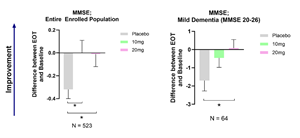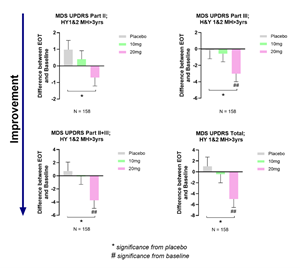-
Annovis Bio Announces New Data from Phase III Parkinson’s Study Highlighting Improvements in Unified Parkinson's Disease Rating Scale (MDS-UPDRS) and Cognition after Treatment with Buntanetap
المصدر: Nasdaq GlobeNewswire / 02 يوليو 2024 08:00:00 America/New_York
Buntanetap showed dose-dependent and statistically significant improvements in cognition in the overall enrolled PD population. Parkinson’s patients with substantial cognitive decline exhibited a very pronounced improvement.
Buntanetap showed statistical improvement in the MDS-UPDRS Part II, Part III, Part II+III and Total scores in Parkinson’s patients with a >3-year diagnosis.
Buntanetap showed the same statistical improvement in MDS-UPDRS Part II, Part III, Part II+III and Total scores in Parkinson’s patients with Postural Instability and Gait Difficulties (PIGD).
Buntanetap’s activity resulted in statistically significant improvements in all primary and secondary endpoints in the specified populations as well as in cognition.MALVERN, Pa., July 02, 2024 (GLOBE NEWSWIRE) -- via IBN -- Annovis Bio Inc. (NYSE: ANVS) (“Annovis” or the “Company”), a late-stage clinical drug platform company pioneering transformative therapies for neurodegenerative disorders such as Alzheimer’s Disease (AD) and Parkinson’s Disease (PD), today announced new data from its Phase III PD study demonstrating that buntanetap is safe and effective in improving motor and non-motor activities and improving cognitive functions in patients with early Parkinson’s disease.
These findings will be discussed in more detail on today's webcast at 4:30 PM ET. Register here.
"We are very pleased to see improvements in many of our patients over such a short course of treatment. These compelling data reinforce our commitment to advancing buntanetap into a longer study, which will allow us not only to verify observed symptomatic improvements but also to explore buntanetap’s disease-modifying properties," said Maria Maccecchini, Ph.D., Founder, President and CEO of Annovis Bio.
Key Findings from the Study:
Buntanetap stops cognitive decline in all enrolled patients (MMSE 20-30) and improves cognition in patients with mild dementia (MMSE 20-26).
-
- Findings: In the entire enrolled population, placebo group demonstrated cognition deterioration throughout the study, whereas all treatment groups (10mg and 20mg buntanetap) maintained baseline levels, indicating a statistically significant effect of the drug in stopping cognitive decline. In patients with mild dementia, as measured by MMSE 20-26, cognition deteriorated at a faster pace in the placebo group compared to those treated with 10mg buntanetap. Moreover, treatment with 20mg buntanetap showed significant improvement in cognition compared to placebo (Figure 1).
- Background: Inclusion criteria for enrollment included MMSE scores between 20-30, and MMSE scores were measured again at the end of the study as an exploratory endpoint. This allowed us to determine changes in cognition in the entire enrolled population as well as in patients with cognitive decline. Most PD patients had normal cognitive functioning, and just 12% showed cognitive decline as measured by MMSE 20-26. These patients declined by 1.5 MMSE points in the placebo group but did not decline at all and even improved when treated with buntanetap. This data aligns with our AD cognition data, where patients with MMSE>20 responded well to buntanetap, showing statistically significant cognitive improvement in early AD patients.
- Findings: In the entire enrolled population, placebo group demonstrated cognition deterioration throughout the study, whereas all treatment groups (10mg and 20mg buntanetap) maintained baseline levels, indicating a statistically significant effect of the drug in stopping cognitive decline. In patients with mild dementia, as measured by MMSE 20-26, cognition deteriorated at a faster pace in the placebo group compared to those treated with 10mg buntanetap. Moreover, treatment with 20mg buntanetap showed significant improvement in cognition compared to placebo (Figure 1).
Buntanetap improves motor and non-motor PD-related functions in patients with a diagnosis of over 3 years.
-
- Findings: Patients with a diagnosis of less than 3 years showed minimal or no deficits in MDS-UPDRS Part II, making it challenging to measure improvement and assess treatment effectiveness. However, in patients diagnosed with PD for longer than 3 years (MH>3), with measurable declines in MDS-UPDRS Part II, 20mg buntanetap significantly improved MDS-UPDRS Part II, Part III, Part II+III, and Total scores compared to placebo and baseline (Figure 2).
- Background: Longitudinal studies from Parkinson’s Progressive Markers Initiative (PPMI) cohorts have shown that Parkinson patients’ self-evaluation of their activities of daily living (MDS-UPDRS Part II) are relatively intact in the early disease stages. They have also shown that MDS-UPDRS Part II deteriorates at a much slower pace compared to the physician-scored motor evaluation (MDS-UPDRS Part III (Holden et al. 2017).
- Findings: Patients with a diagnosis of less than 3 years showed minimal or no deficits in MDS-UPDRS Part II, making it challenging to measure improvement and assess treatment effectiveness. However, in patients diagnosed with PD for longer than 3 years (MH>3), with measurable declines in MDS-UPDRS Part II, 20mg buntanetap significantly improved MDS-UPDRS Part II, Part III, Part II+III, and Total scores compared to placebo and baseline (Figure 2).
Buntanetap improves motor and non-motor PD-related functions in patients with Postural Instability and Gait Difficulty (PIGD).
-
- Findings: PIGD patients treated with buntanetap showed significant improvements in MDS-UPDRS Part II, Part III, Part II-III, and Total scores. The disease in this patient group progresses faster than in other PD patients. Our data showed that PIGD patients respond better to buntanetap and improve further than other Parkinson’s patients (Figure 3).
- Background: Parkinson’s is a very heterogeneous disease. Patients diagnosed with PIGD are considered to have faster disease progression (Jankovic et al. 1990 & Stebbins et al. 2013) than patients with no postural and gait issues. This observation provided us with the rationale to evaluate whether PIGD patients, who are at risk of faster decline, would benefit from buntanetap.
- Findings: PIGD patients treated with buntanetap showed significant improvements in MDS-UPDRS Part II, Part III, Part II-III, and Total scores. The disease in this patient group progresses faster than in other PD patients. Our data showed that PIGD patients respond better to buntanetap and improve further than other Parkinson’s patients (Figure 3).
Safety Profile: Buntanetap maintained a consistent safety profile across all participants, with no significant differences between early and advanced PD patients confirming our previous AD data.
FDA and Endpoint Clarification: Recent questions regarding the primary and secondary endpoints in MDS-UPDRS scores warrants additional explanation. Initially, Annovis chose MDS-UPDRS Part II+III as the primary endpoint. However, based on FDA feedback, MDS-UPDRS Part II alone was deemed more appropriate for reflecting clinically relevant changes (Goetz et al., 2023). Consequently, we adjusted our primary endpoint to MDS-UPDRS Part II, with MDS-UPDRS Part III as a key secondary endpoint. Our results met both primary and secondary endpoints in the specified subgroups.
Upcoming Webcast
Annovis Bio will host an investor webcast today at 4:30 PM ET to discuss these findings in detail. Investors and interested parties are encouraged to register for the webcast in advance.
To register, please visit Webcast Registration and complete the registration form.About Buntanetap
Buntanetap (formerly known as Posiphen or ANVS401) targets neurodegeneration by inhibiting the formation of multiple neurotoxic proteins, including amyloid beta, tau, alpha-synuclein, and TDP43. By improving synaptic transmission, axonal transport, and reducing neuroinflammation, Buntanetap aims to reverse neurodegeneration in AD, PD, and other neurodegenerative diseases, thereby aiming to restore brain function and improve the quality of life for patients.References
- Holden, SK, Finseth, T, Sillau, SH and Berman, BD. Progression of MDS-UPDRS Scores Over Five Years in De Novo Parkinson Disease from the Parkinson's Progression Markers Initiative Cohort. Mov Disord Clin Pract 2018, 5: 47-53. [PubMed]
- Jankovic J, McDermott M, Carter J, et al. Variable expression of Parkinson's disease: a base‐line analysis of the DATATOP cohort. The Parkinson Study Group. Neurology 1990; 40:1529–1534. [PubMed] [Google Scholar]
- Stebbins GT, Goetz CG, Burn DJ, et al. How to identify tremor dominant and postural instability/gait difficulty groups with the movement disorder society unified Parkinson's disease rating scale: comparison with the unified Parkinson's disease rating scale. Mov Disord 2013; 28:668–670. [PubMed] [Google Scholar]
- Goetz, CG, Choi, D., Guo, Y., Stebbins, GT, Mestre, TA., & Luo, S. It Is as It Was: MDSUPDRS Part III Scores Cannot Be Combined with Other Parts to Give a Valid Sum. Movement Disorders 2023, 38(2), 342-347. [PubMed]
About Annovis Bio, Inc.
Headquartered in Malvern, Pennsylvania, Annovis Bio Inc. is dedicated to addressing neurodegeneration in diseases such as AD and PD. The company’s innovative approach targets multiple neurotoxic proteins, aiming to restore brain function and improve the quality of life for patients. For more information, visit www.annovisbio.com and follow us on LinkedIn, YouTube, and X.Interested investors and shareholders are encouraged to sign up for press releases and industry updates by registering for Email Alerts at https://www.Annovisbio.com/email-alerts
Forward-Looking Statements
This press release contains "forward-looking" statements within the meaning of Section 27A of the Securities Act of 1933, as amended, and Section 21E of the Securities Exchange Act of 1934, as amended. These statements include, but are not limited to, the Company's plans related to clinical trials. Forward-looking statements are based on current expectations and assumptions and are subject to risks and uncertainties that could cause actual results to differ materially from those projected. Such risks and uncertainties include, but are not limited to, those related to patient enrollment, the effectiveness of buntanetap, and the timing, effectiveness, and anticipated results of the Company's clinical trials evaluating the efficacy, safety, and tolerability of buntanetap. Additional risk factors are detailed in the Company's periodic filings with the SEC, including those listed in the "Risk Factors" section of the Company's Annual Report on Form 10-K and Quarterly Reports on Form 10-Q. All forward-looking statements in this press release are based on information available to the Company as of the date of this release. The Company expressly disclaims any obligation to update or revise its forward-looking statements, whether as a result of new information, future events, or otherwise, except as required by law.Contacts
Annovis Bio, Inc.
101 Lindenwood Drive
Suite 225
Malvern, PA 19355
www.annovisbio.comInvestor Contact
Scott McGowan
InvestorBrandNetwork (IBN)
Phone: 310.299.1717
IR@annovisbio.com
Investor WebsiteAttachments
- Changes in MMSE after treatment with 10mg or 20mg buntanetap compared to baseline and placebo
- Changes in MDS-UPDRS after treatment with 10mg or 20mg buntanetap in patients with a PD diagnosis over 3 years compared to baseline and placebo
- Changes in MDS-UPDRS after treatment with 10mg or 20mg buntanetap in patients with PIGD

Changes in MMSE after treatment with 10mg or 20mg buntanetap compared to baseline and placebo
Figure 1.
Changes in MDS-UPDRS after treatment with 10mg or 20mg buntanetap in patients with a PD diagnosis over 3 years compared to baseline and placebo
Figure 2.
Changes in MDS-UPDRS after treatment with 10mg or 20mg buntanetap in patients with PIGD
Figure 3.
-



